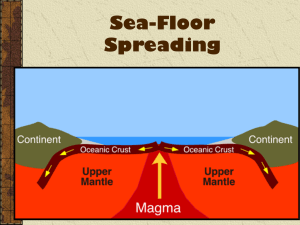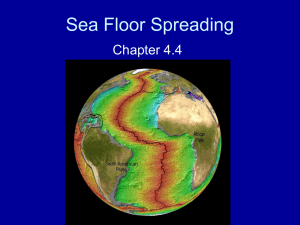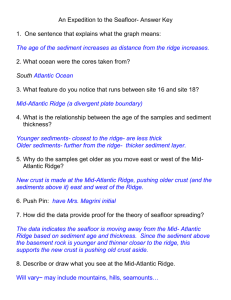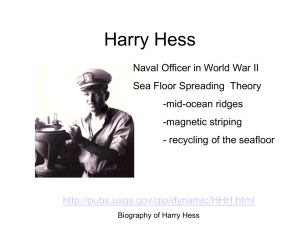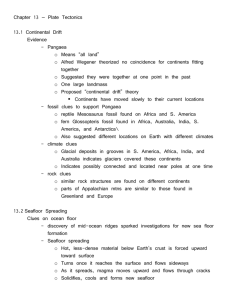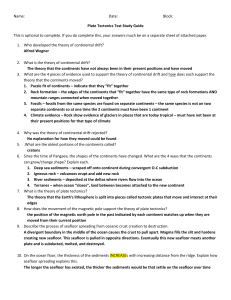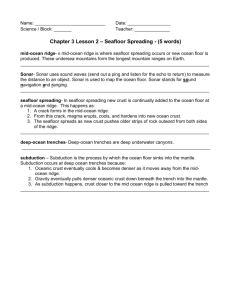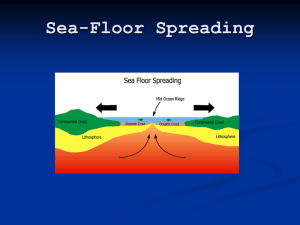Seafloor Spreading
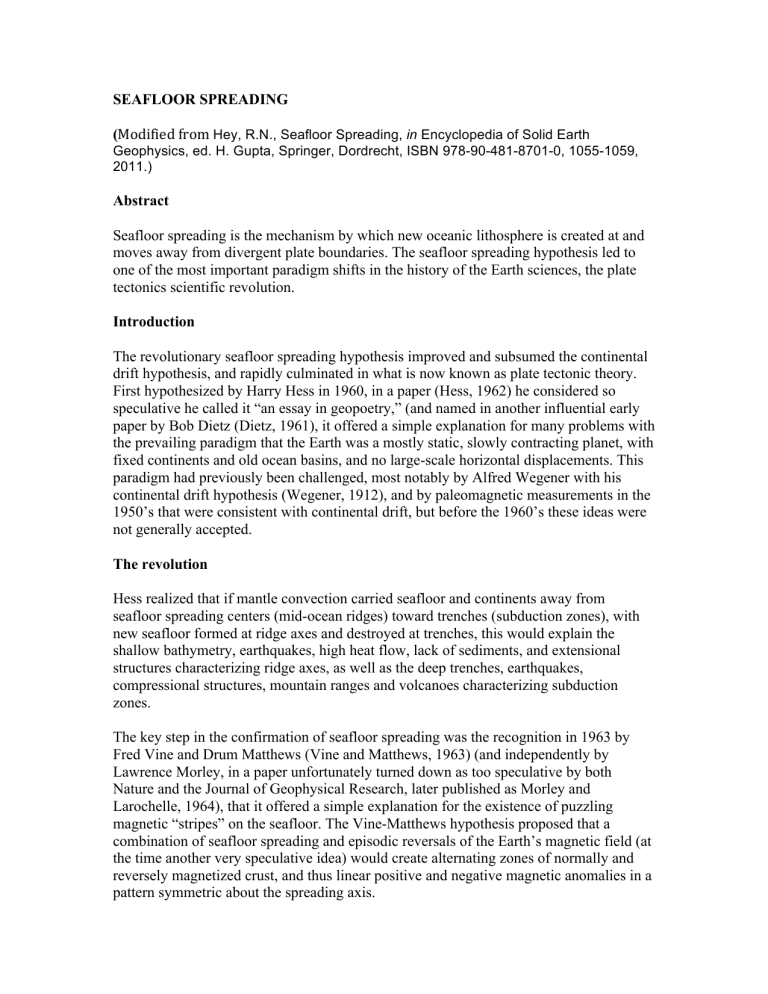
SEAFLOOR SPREADING
( Modified from Hey, R.N., Seafloor Spreading, in Encyclopedia of Solid Earth
Geophysics, ed. H. Gupta, Springer, Dordrecht, ISBN 978-90-481-8701-0, 1055-1059,
2011.)
Abstract
Seafloor spreading is the mechanism by which new oceanic lithosphere is created at and moves away from divergent plate boundaries. The seafloor spreading hypothesis led to one of the most important paradigm shifts in the history of the Earth sciences, the plate tectonics scientific revolution.
Introduction
The revolutionary seafloor spreading hypothesis improved and subsumed the continental drift hypothesis, and rapidly culminated in what is now known as plate tectonic theory.
First hypothesized by Harry Hess in 1960, in a paper (Hess, 1962) he considered so speculative he called it “an essay in geopoetry,” (and named in another influential early paper by Bob Dietz (Dietz, 1961), it offered a simple explanation for many problems with the prevailing paradigm that the Earth was a mostly static, slowly contracting planet, with fixed continents and old ocean basins, and no large-scale horizontal displacements. This paradigm had previously been challenged, most notably by Alfred Wegener with his continental drift hypothesis (Wegener, 1912), and by paleomagnetic measurements in the
1950’s that were consistent with continental drift, but before the 1960’s these ideas were not generally accepted.
The revolution
Hess realized that if mantle convection carried seafloor and continents away from seafloor spreading centers (mid-ocean ridges) toward trenches (subduction zones), with new seafloor formed at ridge axes and destroyed at trenches, this would explain the shallow bathymetry, earthquakes, high heat flow, lack of sediments, and extensional structures characterizing ridge axes, as well as the deep trenches, earthquakes, compressional structures, mountain ranges and volcanoes characterizing subduction zones.
The key step in the confirmation of seafloor spreading was the recognition in 1963 by
Fred Vine and Drum Matthews (Vine and Matthews, 1963) (and independently by
Lawrence Morley, in a paper unfortunately turned down as too speculative by both
Nature and the Journal of Geophysical Research, later published as Morley and
Larochelle, 1964), that it offered a simple explanation for the existence of puzzling magnetic “stripes” on the seafloor. The Vine-Matthews hypothesis proposed that a combination of seafloor spreading and episodic reversals of the Earth’s magnetic field (at the time another very speculative idea) would create alternating zones of normally and reversely magnetized crust, and thus linear positive and negative magnetic anomalies in a pattern symmetric about the spreading axis.
The next key step in the revolution occurred in 1965, when Tuzo Wilson noted that deformation of the Earth’s crust is concentrated in narrow mobile belts, and postulated that these features are all interconnected in a global network, the first qualitative model of plate tectonics (Wilson, 1965). The zones of extension and compression are connected by a new class of faults defined by Wilson as transform faults, which required relative plate motion and turned out to be the most important type of fault on Earth. He showed that seafloor spreading occurring on offset mid-ocean ridge axes would produce relative motion exactly opposite to the motion the sense of offset would predict without seafloor spreading, and that earthquakes should only occur between the offset seafloor spreading axes. These radical predictions, completely opposite to prevailing wisdom, were soon confirmed seismically. Furthermore, by correctly interpreting the San Andreas fault as a transform fault between the Pacific and North America plates, he predicted the existence of previously unrecognized seafloor spreading offshore western North America. Vine and
Wilson (1965) showed that the predicted magnetic symmetry existed in this area, where magnetic stripes had been discovered in the mid-1950’s by Ron Mason and Art Raff
(Mason, 1958; Mason and Raff, 1961; Raff and Mason, 1961), over what they recognized as the Juan de Fuca Ridge, and furthermore that the pattern of stripes corresponded perfectly with the pattern of magnetic field reversals proposed by Allan Cox, Richard
Doell, Brent Dalrymple, and Ian McDougall (Cox, Doell and Dalrymple, 1963;
McDougall and Tarling, 1963), once the Jaramillo anomaly was discovered. Vine (1966) also demonstrated similar symmetry and correlation with the reversal time scale in another important data set, the Project Magnet aeromagnetic data collected over the
Reykjanes Ridge south of Iceland by Jim Heirtzler et al. (1966). His color figures of these classic data sets and correlations (Vine, 1968) became iconic.
The smoking gun for many scientists was the discovery by Walter Pitman (Pitman and
Heirtzler, 1966) of near perfect symmetry in the Eltanin-19 profile collected over the
Pacific-Antarctic Ridge. Essentially every tiny wiggle seen in the magnetic anomaly profile on the Pacific plate was mirrored on the Antarctic plate, and correlated perfectly with the magnetic reversal time scale. The symmetry in these data required a symmetric axial process, with new seafloor carried away on both plates, and thus provided compelling evidence for both the Vine-Matthews and seafloor spreading hypotheses.
Vine convincingly summarized this evidence in influential symposia and publications
(Vine, 1966; 1968), and by the end of 1966 seafloor spreading was generally accepted by marine geophysicists, who quickly extrapolated the magnetic reversal time scale from
~10 Ma to ~80 Ma and worked out at least the basic recent evolutionary history of every ocean basin.
This scientific revolution culminated in plate tectonics the following year when Jason
Morgan (Morgan, 1968) and Dan McKenzie (McKenzie and Parker, 1967) made the key assumption that plates behave rigidly, and extended Wilson’s transform fault geometry to the sphere. They showed that transforms are small circles about rotation poles describing relative plate motion, that seafloor spreading rates increase as the sine of the angular distance away from these poles, and that it was possible to use known patterns of seafloor spreading to quantitatively predict other plate motions and plate boundary evolution.
Ridge axis geometry, morphology and crustal formation
Volcanism along the mid-ocean ridge system has formed the longest mountain chain on
Earth. As the plates slowly (~0-150 mm/yr, or km/Myr, at present, DeMets et al., 2010, with rates remarkably similar whether using magnetic anomalies or geodetic measurements such as GPS) move apart by seafloor spreading, magma from the hot asthenosphere rises to fill the crack at mid-ocean ridge axes, elevated because of the higher temperatures. Both axial depth and morphology correlate with spreading rate
(Macdonald, 1982). Fast spreading ridge axes such as the East Pacific Rise generally have shallow depths and relatively smooth morphologies, with very small extensional axial summit troughs (except where these are completely buried by the latest eruption in the neovolcanic rift zone). Slow spreading ridges such as the Mid-Atlantic Ridge generally have much deeper, rougher, and higher-amplitude axial valleys, except near hotspots such as Iceland where magma supply is unusually large and even slow-spreading axes have shallow axes with fast-spreading morphology.
The asthenosphere typically melts to become mid-ocean ridge basalt in a magma chamber under the ridge axis. Some basalt is erupted onto the seafloor to form pillow basalts and lava flows, which are progressively covered by sediments as the lithosphere ages and moves away from the axis. Below the basalts are the sheeted dikes, the paths through which the lava moved from magma chambers to the surface, and below the dikes are the layered gabbros which cooled and crystallized in place (intrusives) rather than erupting at axial volcanoes (extrusives). This typical sequence of mantle ultramafics - gabbro – sheeted dikes – extrusive basalts – sediments is observed on the seafloor in tectonic windows where existing lithosphere is rifted apart, and also where slices of old ocean lithosphere are thrust into ophiolite mountain belts as in Oman and Cyprus (Karson,
1982).
Hydrothermal vents
As the new seafloor cools it contracts and cracks. Water goes down these cracks, is heated, reacts with the surrounding rocks, and comes back up as buoyant hydrothermal vents (Baker and German, 2004). These occur at a range of chemistries and temperatures, up to ~400°C in black smokers, so-called because of the sulfide-rich plumes that precipitate suddenly when the superheated water is injected into the surrounding ~2°C seawater, forming sulfide chimneys. White and clear smokers occur at lower temperatures. The chemical reactions provide energy for an unusual kind of life that does not depend on photosynthesis but flourishes as chemosynthetic communities at many of these vents, rare deep-ocean oases in an otherwise extremely barren environment (Kelley et al., 2002).
Summary
Seafloor spreading was a critical step in the contentious scientific revolution from the previous static Earth paradigm to the now universally accepted plate tectonic paradigm.
Today it refers to the processes creating new oceanic lithosphere where plates move apart. Seafloor spreading replaces the lithosphere destroyed by subduction, and exerts important influences on Earth’s chemical and biological evolution.
References
Baker, E.T. and C.R. German, 2004. On the global distribution of hydrothermal vent fields. In German et al. (eds.) Mid-Ocean Ridges: Hydrothermal Interactions Between the
Lithosphere and Oceans, Geophysical Monograph 148, American Geophysical Union:
245-266.
Cox, A., R.R. Doell and G.B. Dalrymple, 1963. Geomagnetic polarity epochs and
Pleistocene geochronometry. Nature, 198: 1049-1051.
DeMets, C., R.G. Gordon and D.F. Argus, 2010. Geologically current plate motions.
Geophysical Journal International, 181(1): 1-80. doi: 10.1111/j.1365-246X.2009.04491.x
Dietz, R.S., 1961, Continent and ocean basin evolution by spreading of the sea floor.
Nature, 190: 854-857.
Heirtzler, J.R., X. Le Pichon, and J.G. Baron, Magnetic anomalies over the Reykjanes
Ridge, Deep Sea Res.
, 13 , 427–443, 1966.
Hess, H.H., 1962, History of ocean basins. In Engel, A.E.J., H.L. James, and B.F.
Leonard, eds., Petrologic Studies: A Volume to Honor A.F. Buddington: Geological
Society of America: 599-620.
Karson, J.A., 2002. Geologic structure of the uppermost oceanic crust created at fast- to intermediate-rate spreading centers. Annual Reviews of Earth and Planetary Science, 30:
347-384.
Kelley, D.S., J.A. Baross and J.R. Delaney, 2002. Volcanoes, fluids and life at mid-ocean ridge spreading centers, Annual Reviews of Earth and Planetary Science, 30: 385-491.
McDougall, I., and D.H. Tarling, 1963. Dating of polarity zones in the Hawaiian Islands.
Nature, 200: 54-56.
McKenzie, D.P., and R.L. Parker, 1967. The North Pacific: An example of tectonics on a sphere. Nature, 216: 1276-1280.
Macdonald, K.C., 1982. Mid-ocean ridges: Fine scale tectonic, volcanic and hydrothermal processes within the plate boundary zone. Annual Reviews of Earth and
Planetary Science, 10: 155-190.
Mason, R.G., 1958. A magnetic survey over the west coast of the United States between latitudes 32° and 36° N, longitudes 121° and 128° W. Geophysical Journal of the Royal
Astronomical Society, 1: 320-329.
Mason, R.G. and A.D. Raff, 1961. A magnetic survey off the west coast of North
America
32° N to 42° N. Bulletin of the Geological Society of America, 72: 1259-1265.
Morgan, W.J., 1968. Rises, trenches, great faults and crustal blocks. Journal of
Geophysical Research, 73: 1959-1982.
Morley, L. W. and A. Larochelle, 1964. Paleomagnetism as a means of dating geological events. Geochronology in Canada (Royal Society of Canada) Special Publication 8: 39–
50.
Pitman, W.C. III and J.R. Heirtzler, 1966. Magnetic anomalies over the Pacific-Antarctic
Ridge. Science, 154: 1164-1171.
Raff, A.D. and R.G. Mason, 1961. Magnetic survey off the west coast of the United
States between 40°N latitude and 52°N latitude. Bulletin of the Geological Society of
America 72: 1267–1270.
Vine, F.J., 1966. Spreading of the ocean floor: New evidence. Science, 154: 1405-1415.
Vine, F.J., 1968. Magnetic anomalies associated with mid-ocean ridges. In Phinney,
R.A., ed., The History of the Earth’s Crust: Princeton University Press, 73-89.
Vine, F.J. and D.H. Matthews, 1963. Magnetic anomalies over oceanic ridges. Nature,
199: 947-949.
Vine, F.J. and J.T. Wilson, 1965. Magnetic anomalies over a young oceanic ridge off
Vancouver Island. Science 150: 485-489.
Wegener, A., 1912. Die entstehung der kontinente. Geologishe Rundschau, 3: 276-292.
Wilson, J.T., 1965. A new class of faults and their bearing on continental drift. Nature,
207: 343-347.
